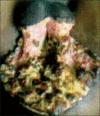Nonmelanoma skin cancer in India: current scenario
- PMID: 21430894
- PMCID: PMC3051301
- DOI: 10.4103/0019-5154.74551
Nonmelanoma skin cancer in India: current scenario
Abstract
Incidence of skin cancers has been increasing since the last few decades worldwide. Nonmelanoma skin cancer (NMSC) is the commonest variety of cutaneous malignancy. Conventional wisdom has it that the incidence of all varieties of skin cancers is lower among Indians due to the protective effects of melanin. Though national surveys and cross-country data in India are unavailable, there are indirect indications from several smaller reports that NMSCs may be on the rise in India. Reports of quite a few atypical cases lead us to hypothesize that factors other than ultraviolet radiation may be important in the occurrences of these cancers, particularly in the skin types prevalent in India. The descriptive epidemiology and clinical characteristics of squamous and basal cell carcinoma in India, including their variants, are discussed here along with hypotheses on their etiopathogenesis. Novel management techniques currently available in India are also highlighted.
Keywords: Squamous cell carcinoma; basal cell carcinoma; nonmelanoma skin cancer.
Conflict of interest statement
Figures



References
-
- Preston DS, Stern RS. Nonmelanoma cancers of the skin. N Engl J Med. 1992;327:1649–62. - PubMed
-
- Yamaguchi Y, Beer JZ, Hearing VJ. Melanin mediated apoptosis of epidermal cells damaged by ultraviolet radiation: factors influencing the incidence of skin cancer. Arch Dermatol Res. 2008;300:S43–50. - PubMed
-
- Boring CC, Squires TS, Tong T. Cancer statistics, 1991. CA Cancer J Clin. 1991;41:19–36. - PubMed
-
- Gallagher RP, Ma B, McLean DI, Yang CP, Ho V, Carruthers JA, et al. Trends in basal cell carcinoma, squamous cell carcinoma, and melanoma of the skin from 1973 through 1987. J Am Acad Dermatol. 1990;23:413–21. - PubMed
-
- Casson P. Basal cell careinoma. Clin Plast Surg. 1980;7:301–11. - PubMed
LinkOut - more resources
Full Text Sources
